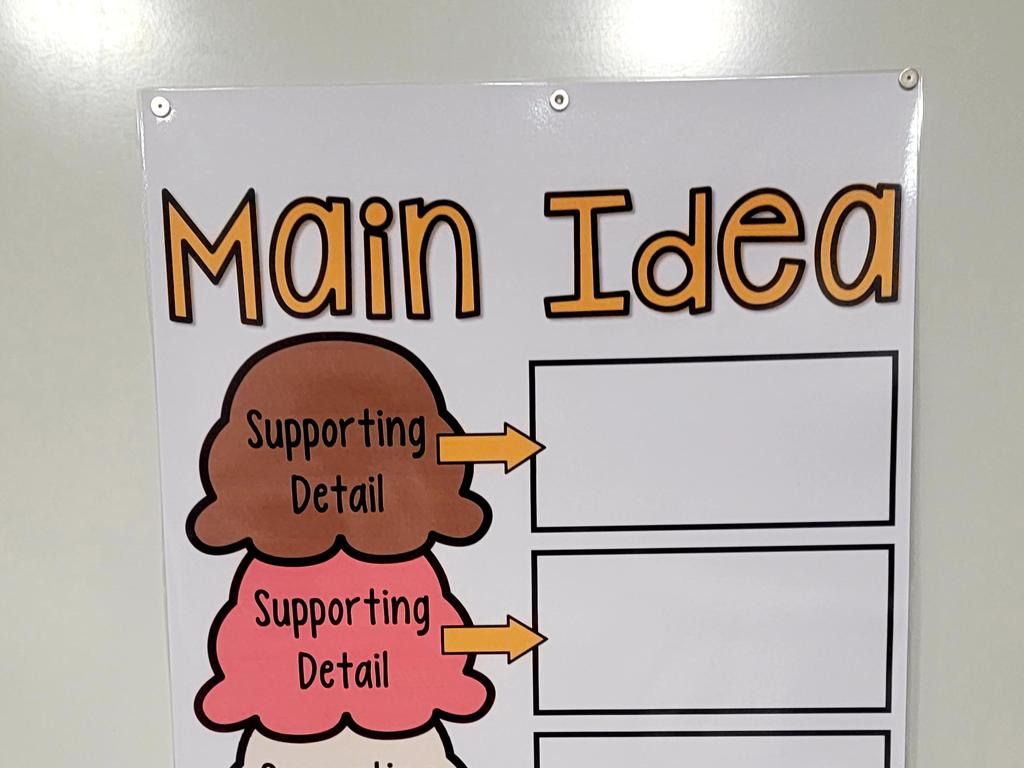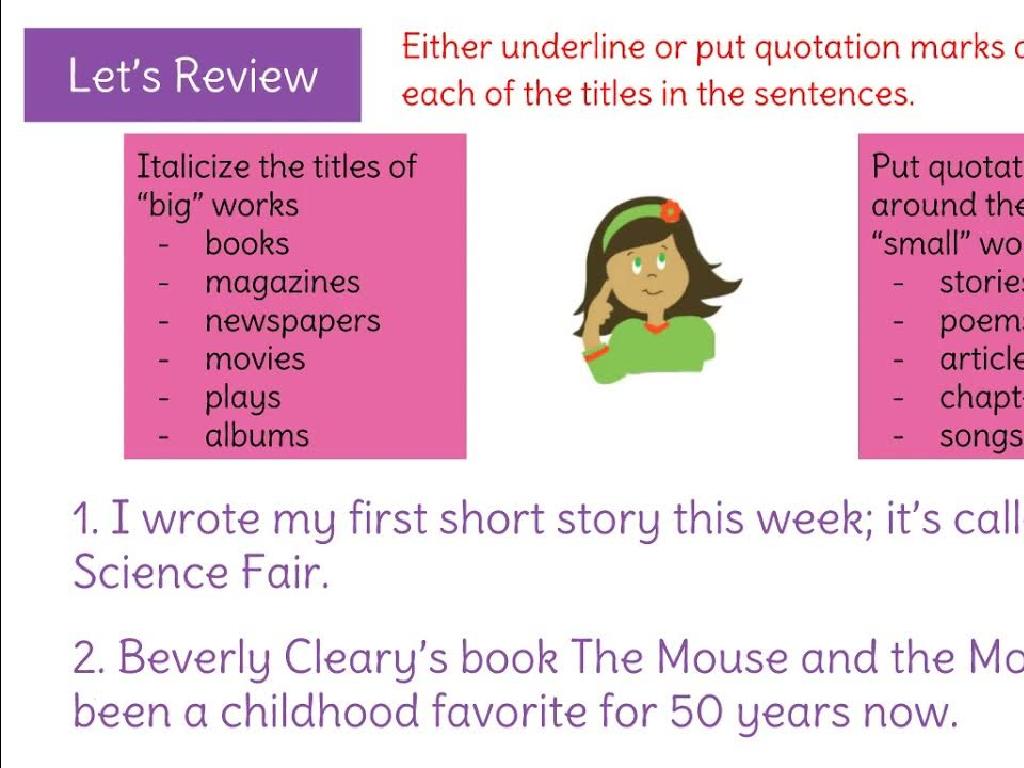Identify Appositives And Appositive Phrases
Subject: Language arts
Grade: Seventh grade
Topic: Phrases And Clauses
Please LOG IN to download the presentation. Access is available to registered users only.
View More Content
Appositives: Enhancing Sentences
– Define appositives and phrases
– An appositive is a noun that renames another noun right beside it, e.g., ‘The insect, a cockroach, is crawling.’
– Importance of appositives in writing
– Appositives add detail and clarify nouns for the reader.
– Identifying appositives in sentences
– Look for nouns followed by another noun or phrase that explains it.
– Practice using appositives
|
This slide introduces the concept of appositives and appositive phrases, which are essential tools for adding detail and clarity to writing. An appositive is a noun or noun phrase that sits next to another noun to rename or describe it further. This lesson will help students recognize appositives in sentences and understand their function. By learning to identify and use appositives, students can make their writing more descriptive and precise. Encourage students to find examples of appositives in books they read or in their own writing. For practice, they can create sentences with appositives or add appositives to existing sentences to provide additional information about a noun.
Understanding Appositives
– Define an appositive
– A noun or noun phrase that renames another noun right beside it
– Examples in sentences
– My brother, a doctor, works at a hospital.
– Appositives add information
– They provide extra details about the noun they follow or precede.
– Usage in writing
|
This slide introduces the concept of appositives, which are nouns or noun phrases that sit next to another noun to rename or provide additional information about it. Use examples to illustrate how appositives can clarify or add detail to a sentence. Explain that appositives can be essential for adding depth to writing, making it more engaging and informative. Encourage students to identify appositives in their reading and think about how they might use them in their own writing to add detail and interest.
Exploring Appositive Phrases
– Expanding sentences with appositives
– An appositive is a noun that renames another noun next to it, e.g., ‘The insect, a cockroach, is crawling.’
– Appositive phrases add detail
– They provide extra information about a noun without starting a new sentence.
– Examples of appositive phrases
– ‘My brother, an engineer, fixed the car.’ The phrase ‘an engineer’ is an appositive.
– Practice identifying appositives
– Find appositives in books or create your own sentences.
|
This slide introduces appositive phrases, which are groups of words that include an appositive and its modifiers, usually providing additional information about a noun in a sentence. They are a useful tool for adding detail and clarity without the need for multiple sentences. Provide clear examples to illustrate how appositive phrases can be seamlessly integrated into writing. Encourage students to practice by identifying appositive phrases in their reading or by creating sentences that include them. This will help reinforce their understanding of how appositives function within the structure of a sentence.
Punctuating Appositives Correctly
– Commas with appositives
– Use commas to offset appositives from the rest of the sentence
– Pair of commas for non-restrictive
– Non-restrictive: extra info not crucial to the meaning (e.g., My brother, a doctor, is visiting.)
– No commas for restrictive
– Restrictive: crucial to the meaning (e.g., The teacher Mrs. Smith is here.)
– Practice punctuating appositives
|
This slide aims to teach students how to correctly punctuate appositives, which are nouns or noun phrases that rename or clarify another noun. Commas are used to separate non-restrictive appositives, which provide additional information that is not essential to the sentence’s meaning, from the rest of the sentence. In contrast, restrictive appositives, which are essential to the meaning of the sentence, do not require commas. Provide examples for both cases and have students practice with sentences, determining whether the appositives are restrictive or non-restrictive and punctuating them accordingly.
Identifying Appositives
– Practice identifying appositives
– Find appositives in provided sentences
– Discuss the role of appositives
– Why does the sentence need the appositive?
– Share examples with peers
– Exchange findings with classmates
– Understand appositives’ value
|
This slide is aimed at engaging students in the practical application of identifying appositives in sentences. Appositives are nouns or noun phrases that rename or clarify another noun right beside it. The activity will help students recognize how appositives provide additional information about a noun, making sentences more informative and interesting. Instruct students to look for commas that often set off appositives from the rest of the sentence. After identifying appositives, students should discuss their purpose and how they add detail or clarification. Encourage students to share their examples with the class to foster a collaborative learning environment. This exercise will enhance their understanding of how language can be enriched with descriptive elements.
Crafting Sentences with Appositives
– Write sentences with appositives
– Create sentences, include appositives to clarify nouns
– Use appositives for detail
– Appositives add interesting details to your sentences
– Exchange with a classmate
– Share your sentences with a peer for review
– Discuss the appositives used
– Provide feedback on the use of appositives
|
This slide introduces an interactive class activity focused on creating and identifying appositives. Students will write their own sentences incorporating appositives to add detail and interest to their writing. After writing, they will exchange their sentences with a classmate for peer review. This activity encourages students to understand how appositives can enhance their writing by providing additional information about a noun. It also allows them to practice giving and receiving constructive feedback. Teachers should monitor the exchanges to ensure that the feedback is helpful and that students understand the concept of appositives. Possible activities include writing sentences about historical figures, characters from a book, or their own classmates using appositives.
Class Activity: Appositive Hunt
– Find appositives in a book/article
– Write sentences and appositives
– Note the sentence and the noun or phrase that renames it
– Share with the class
– Explain appositive’s function
– Discuss how the appositive adds detail or clarifies the noun
|
This activity is designed to help students identify appositives and appositive phrases in context. Students should choose a book or article they enjoy and look for sentences containing appositives. They will write down both the sentence and the appositive phrase, then share their findings with the class. This will help them understand how appositives provide additional information about a noun without the need for a full relative clause. For the teacher: Prepare to guide students on what an appositive is, and provide examples. Encourage students to explain how the appositive they found adds detail or clarification to the sentence. Possible activities: 1) Pair students to find appositives in each other’s books. 2) Create a classroom ‘Appositive Wall’ where students post their sentences. 3) Have students create their own sentences with appositives. 4) Role-play: One student says a noun, another adds an appositive.
Review: Appositives and Their Importance
– Recap on appositives and phrases
– Appositives are nouns that rename another noun right beside it, e.g., ‘The insect, a cockroach, is crawling.’
– Significance of appositives in writing
– They add detail and clarify sentences, making writing more engaging and precise.
– Homework: Find appositive examples
– Look for sentences with commas and see if they contain appositives. Bring examples to class.
|
As we wrap up today’s lesson, let’s review the key concepts of appositives and appositive phrases. Remember, an appositive is a noun or noun phrase that renames or provides additional information about another noun right next to it. Understanding how to use appositives effectively can enhance your writing by adding detail and clarity. For homework, I want you to find examples of appositives in any text you read. Look for nouns followed by a comma and see if it introduces another noun or phrase that gives more information about the first noun. Bring these examples to our next class, and we’ll discuss how they add to the sentences. This exercise will help reinforce today’s lesson and improve your ability to recognize and use appositives in your own writing.





